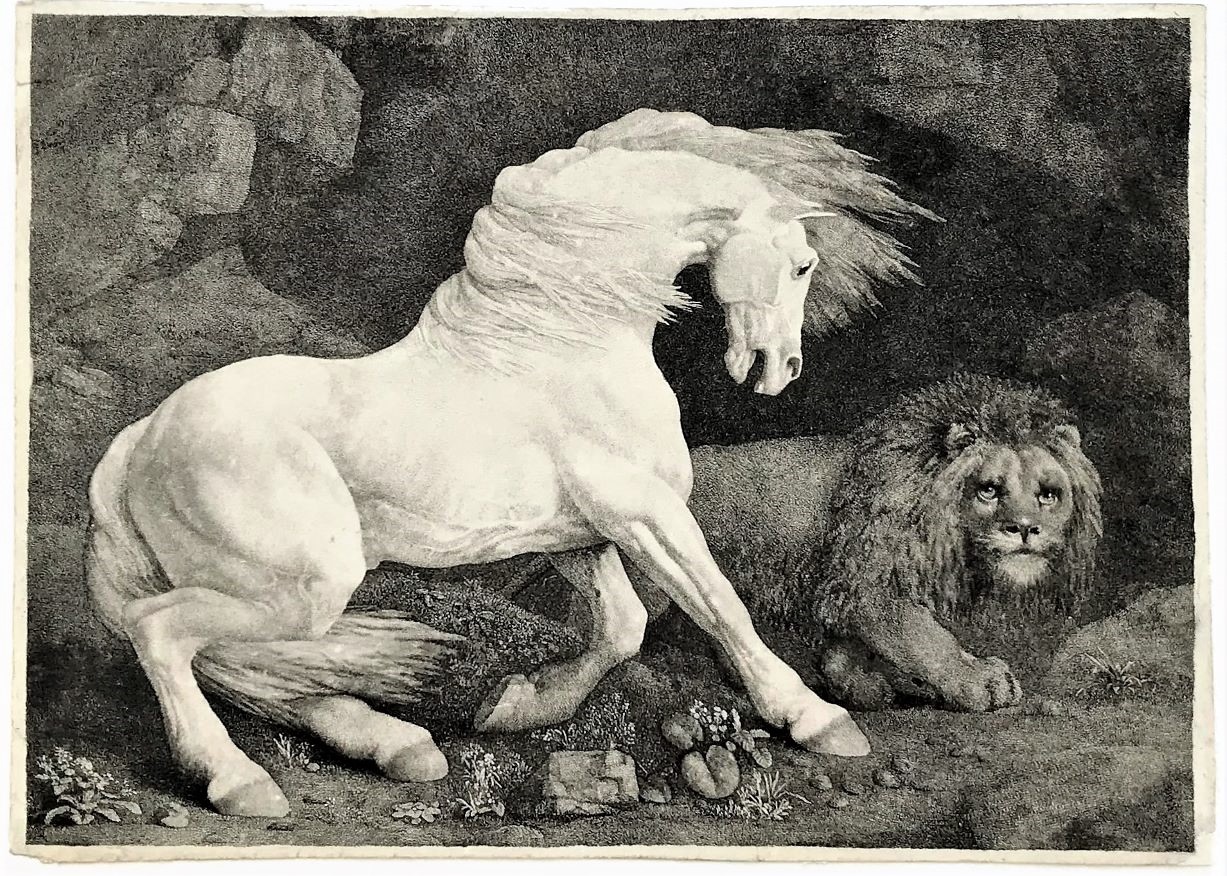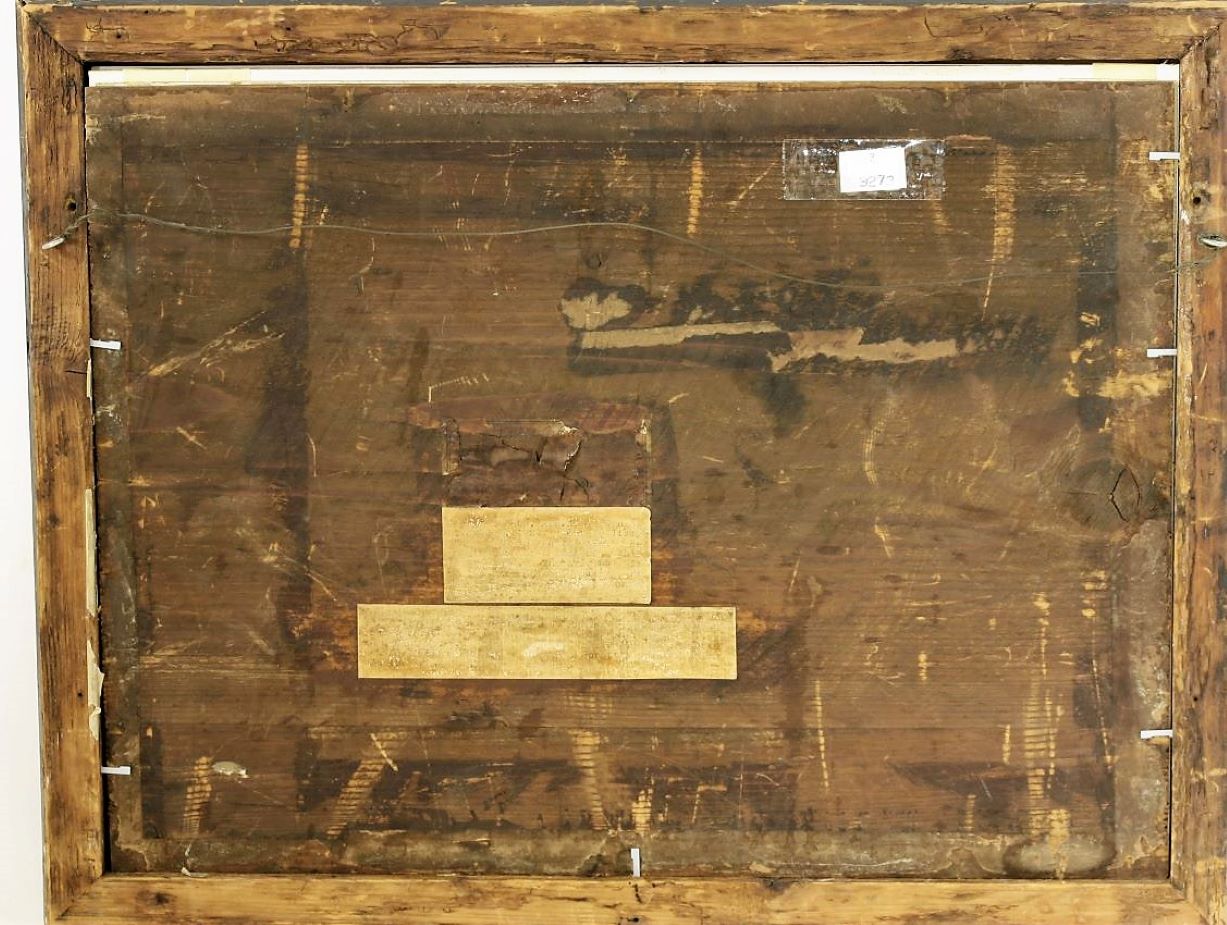![]()
George Stubbs A.R.A. 1724-1806.



A Horse Affrighted at a Lion. Published May 1, 1788. Etching with roulette work. Lennox-Boyd 70.ii or iii. The image is trimmed with the platemark and the etched inscriptions have been trimmed off. Image: 9 x 12 1/2 (sheet: 9 1/8 x 12 3/4). Three unobtrusive flattened folds: a 2-inch diagonal fold along the top left-hand corner; a 5/8-inch diagonal fold in the lower right-hand corner; a 4 1/4-inch fold line in the lower right-hand corner. Two small dark spots the horse's left leg that are iron in the paper. A strong impression printed on unwatermarked white wove paper. Written in pencil on the verso is '1/6' or '9/1'. Housed in an archival mat and possibly the original 15 1/4 x 19 1/8-inch black wood frame with a gold fillet. Price upon request.
On the wooden backing board are two typed stickers, transcribed as follows:
'George Stubbs A.R.A. Born at Liverpool, 1724. Went to Italy 1754, and worked in Rome. He was the son of a surgeon. This is his work. The original is in the National Art Gallery. He was a great anatomical and animal painter'.
The second typed sticker reads:
'This picture was presented to J. McCunn by Sampson Bennett JRCVS [Associate of the Royal College of Veterinary Surgeons], to whom it was presented by Mr Spratt [d. 1920], a fellow of St Catherine's College Cambridge. Mr Bennett had successfully operated upon Mr Spratt's spaniel which was the subject of renal calculus'.
![]()
Sampson Charles Jenkin Bennett, known as Charles, was born in Cambridge in the summer of 1894, the son of a Veterinary Surgeon, Sampson Bennett, Senior, who practiced in Cambridge.
![]()
T.N., who noted he was a friend of Stubbs's life-long companion, Mary Spencer, described an encounter that Stubbs had while visiting Italy, in an article published two years after the artist's death:
"One evening, while Stubbs and his friend were viewing the delightful scenery, and a thousand beautiful objects, from this elevation, which the brilliancy of the moon rendered more interesting, a lion was observed at some distance, directing his way, with a slow pace, towards a white Barbary horse, which appeared grazing not more than two hundred yards distant from the moat [of the private zoo]. Mr. Stubbs was reminded of the gratification he had so often wished for. The orb of night was perfectly clear, and the horizon serene. The lion did not make towards the horse by a regular approach, but performed many curvatures, still drawing nearer towards the devoted animal, till the lion, by the shelter of a rocky situation, came suddenly upon his prey. The affrighted barb beheld his enemy, and, as if conscious of his fate, threw himself into an attitude highly interesting to the painter. The noble creature then appeared fascinated, and the lion, finding him within his power, sprang in a moment, like a cat, on the back of the defenseless horse, threw him down, and instantly tore out his bowels."
T.N. in The Sporting Magazine (May 1808): 55-7 and (July 1808): 155-7; cited in Basil Taylor, "George Stubbs: 'The Lion and Horse' Theme," The Burlington Magazine, vol. 107, no. 743 (February 1965): 82.
![]()
Stubbs's contemporary Ozias Humphrey recorded another incident:
"The White Horse frightened at the Lion was painted from one of the King's Horses in the Mews which Mr. Payne the Architect procured for him. The expression of terror was produced repeatedly, from time to time by pushing a brush upon the ground towards him, and this, aided by his anatomical skill, enabled him to give sentiment of expression and apprehension to the animal which the picture represents."
Cited in Basil Taylor, "George Stubbs: 'The Lion and Horse' Theme," The Burlington Magazine, vol. 107, no. 743 (February 1965): 82.
![]()
Constance-Anne Parker notes that A Lion Attacking a Horse was part of a larger project in Stubbs's career:
"In this extraordinarily productive period of the 1760s, after Stubbs had returned from Horkstow and had set up in London, he began on the second of his three themes. It was to last longer than his frieze of 'Mares and Foals' theme. It was his most interesting and original set of variations on an idea, and by far his most ambitious one. The basis for this theme is a lion and a horse in opposition to each other. He painted the episode in four different stages. There are two versions of the horse being stalked by the lion…The second version is of the horse in obvious danger, showing terror, the lion having come into the foreground of the picture, a comparatively small but menacing figure. The third phase shows the lion, having attacked the horse and leapt on to its back, sinking his teeth into its withers. The final version shows the horse having sunk down to the ground."
Constance-Anne Parker, Mr Stubbs the Horse Painter. (London: J.A. Allen, 1971), 72.
![]()
![]()
To order, to report broken links or to be placed on the email list, please contact Jane Allinson (jane@allinsongallery.com), call (001) 860 429 2322 or fax (001) 860 429 2825. Business hours are 9:A.M. to 5 P.M. Eastern Standard Time.
Please click here to review the USE AND ACCEPTANCE AND PRIVACY POLICIES FOR THE ALLINSON GALLERY, INC. WEBSITE
Thank you for visiting this website.